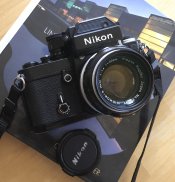So when I bought my Nikon F2SB (Nikon F2 with DP-3 metered finder) last week, I brought some fresh (literally in the package) 1.5v batteries, so I could test the meter in the shop. It seemed fine, and so did everything else, so I bought it (at a very reasonable price, considering that the DP-3 often commands a bit of a premium).
I took it for a test run immediately, with my favorite Nikkor 5cm lens and some Fujicolor Superia 400, rated @ 200 ASA (I love the performance of this film when rated that way, and it's my favorite film speed to work with anyways). All of the exposures recommended by the DP-3 head seemed instinctively correct to me for a 200 ASA film--most of the time I was using it in very bright sunlight at f/8 with shutter speeds in the 1/500-1/2000 range, which I probably would have been doing even without the meter, but it's nice to have confirmation, right?
Well, the pictures turned out excellent in terms of thickness, color response and dynamic range, but then the next day, I accidentally left the wind lever in the "on" position with the camera sitting in a partially sunlit room with no lens cap on. It must have stayed like that for most of the day. Since then, the meter has been wanting me to overexpose by two whole stops--it's still linear, and when I adjust the ASA dial to compensate I still get very accurate exposures. (I did, obviously, check to make sure the aperture was properly indexed and that the ASA dial was mated to the shutter speed dial correctly.)
Now, I'm used to the principle that most battery-powered meters (usually CdS, but Silicon Blue in this case) want to overexpose as the battery runs down, as they are receiving less voltage, which reads as lower light value. I've used plenty of cameras designed for the old mercury cells with shorter-lived alkali batteries instead, which tend to underexpose for most of the battery life, then overexpose towards the very end, so the principle is fairly instinctual to me at this point.
But is such an extreme overexposure normal for just the amount of drain that one day sitting in partial sunlight would put on these weird little batteries? Or is something else wrong with my meter?
I took it for a test run immediately, with my favorite Nikkor 5cm lens and some Fujicolor Superia 400, rated @ 200 ASA (I love the performance of this film when rated that way, and it's my favorite film speed to work with anyways). All of the exposures recommended by the DP-3 head seemed instinctively correct to me for a 200 ASA film--most of the time I was using it in very bright sunlight at f/8 with shutter speeds in the 1/500-1/2000 range, which I probably would have been doing even without the meter, but it's nice to have confirmation, right?
Well, the pictures turned out excellent in terms of thickness, color response and dynamic range, but then the next day, I accidentally left the wind lever in the "on" position with the camera sitting in a partially sunlit room with no lens cap on. It must have stayed like that for most of the day. Since then, the meter has been wanting me to overexpose by two whole stops--it's still linear, and when I adjust the ASA dial to compensate I still get very accurate exposures. (I did, obviously, check to make sure the aperture was properly indexed and that the ASA dial was mated to the shutter speed dial correctly.)
Now, I'm used to the principle that most battery-powered meters (usually CdS, but Silicon Blue in this case) want to overexpose as the battery runs down, as they are receiving less voltage, which reads as lower light value. I've used plenty of cameras designed for the old mercury cells with shorter-lived alkali batteries instead, which tend to underexpose for most of the battery life, then overexpose towards the very end, so the principle is fairly instinctual to me at this point.
But is such an extreme overexposure normal for just the amount of drain that one day sitting in partial sunlight would put on these weird little batteries? Or is something else wrong with my meter?











